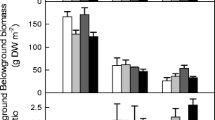Abstract
The life cycle and growth ofPotamogeton crispus L. were studied in a shallow pond, Ojaga-ike. With respect to the shoot elongation and seed and turion formations, the life cycle of this plant in the pond could be divided into following five stages: germination, inactive growth, active growth, reproductive and dormant stages. It was suggested that the plant showed these successive stages depending mainly upon water temperature. The turions germinated on the bottom in autumn when the water temperature fell below ca. 20 C. The plant showed hardly any growth during winter (December—early March) when the temperature was below 10 C. In the spring when the bottom water temperature rose to above 10 C (mid-March), the plant started to grow again and the shoot elongated rapidly at the rate of 4.2 cm day−1 until the shoot apex reached the pond surface in late April. Both the increment of node number and the internodal elongation were associated with this rapid shoot growth. On 10 May (last sampling date), the mean values of shoot length, internodal length and the number of nodes estimated for 10 predominant plants were 238.2±5.6 cm, 7.1±0.8 cm and 34.9±4.0 cm, respectively. The turion formation and flowering occurred during the period from mid-April to mid-May when the surface water temperature ranged 19 and 22 C. The dry weight of a plant reached the maximum mean value of 1180 mg on 10 May. At its peak biomass, an individual plant produced 1–10 turions (5.5 on average) of which the mean individual turion dry weight was 53.2 mg. The turion dry weight accounted for ca. 42% of the total plant biomass m−2 at that time.
Similar content being viewed by others
References
Arber, A. 1920. Water Plants. A Study of Aquatic Angiosperms. Cambridge Univ. Press, Cambridge.
Clos, D. 1856. Mode de propagation particulier auPotamogeton crispus L. Bull. de la Soc. bot. de France3: 350–352.
Glück, H. 1906. Biologische und morphologische Untersuchungen über Wasser- und Sumpfgewächse. Zweiter Teil: Untersuchungen über die mitteleuropäischenUtricularia-Arten, über die Turionenbildung bei Wasserpflanzen, sowie überCeratophyllum. Gustav Fischer, Jena.
Hamashima, S., H. Tanaka andM. Yatazawa. 1977. Water quality and aquatic macrophytes of artificial reservoirs in Tokai-Kinki districts. Report of Environment and Human Survival p. 39–45. Ministry of Education, Science and Culture, Tokyo (in Japanese).
Hutchinson, G.E. 1975. A treatise on limnology. Vol. III-Limnological Botany. John Wiley & Sons, New York.
Ikushima, I. 1965. Ecological studies on the productivity of aquatic plant communities I. Measurement of photosynthetic activity. Bot. Mag. Tokyo78: 202–211.
Ikushima, I. 1966. Aquatic plants in Lake Biwa. The interim report by the investigative group of biological resources in Lake Biwa p. 313–341. Ministry of Construction, Kinki branch (in Japanese).
Kadono, Y. 1978. GenusPotamogeton in Kansai district. Nature Study24: 38–40, 55–57 (in Japanese).
— 1980. Photosynthetic carbon sources in somePotamogeton species. Bot. Mag. Tokyo93: 185–194.
Kunii, H., K. Maeda, S.S. Sastroutomo andI. Kusima. 1980. Seasonal changes of water quality in Ojaga-ike (Pond) dominated by aquatic macrophytes in summer, in Chiba, Japan. Bull. Marine Lab. Chiba Univ.12: 31–40.
— andK. Maeda. 1982. Seasonal and long-term changes in surface cover of aquatic plants in a shallow pond, Ojaga-ike, Chiba, Japan. Hydrobiol.87: 45–55.
Maeda, K. 1980. The role of aquatic macrophytes in the phosphorus cycle in a pond. M. Sci. Thesis of Chiba Univ. (in Japanese).
Maeda, K. and I. Ikusima. 1978. Turion formation and phosphorus cycle ofPotamogeton crispus L. Proc. 25th Ecol. Soc. Jap. p. 15. (in Japanese).
Miki, S. 1927. Oekologische Studien über die Sumpf- und Wassergewächse sowie ihre Formationen im Ogura-Teiche. Report on the historical remains and scenic places in Kyoto8: 81–145 (in Japanese).
— 1937. The water phanerogams in Japan, with special reference to those of Proy. Yamashiro. Report on the historical remains and scenic places in Kyoto17: 1–127 (in Japanese).
Moore, E. 1913. The Potamogetons in relation to pond culture. Bull. Bureau Fisheries, Washington33: 251–291.
Oberdorfer, E. 1949. Pflanzensociologische Exkursionsflora für Süddeutschland. Verlag Eugen Ulmer, Stuttgart.
Rogers, K.H. andC.M. Breen. 1980. Growth and reproduction ofPotamogeton crispus in a South African lake. J. Ecol.68: 561–571.
Saitoh, M., K. Narita andS. Isikawa. 1970. Photosynthetic nature of some aquatic plants in relation to temperature. Bot. Mag. Tokyo83: 10–12.
Sastroutomo, S.S. 1980. Environmental control of turion formation in curly pondweed (Potamogeton crispus). Physiol. Plant.49: 261–264.
— 1981. Turion formation, dormancy and germination of curly pondweed,Potamogeton crispus L. Aquat. Bot.10: 161–173.
—,I. Ikusima, M. Numata andS. Iizumi. 1979. The importance of turions in the propagation of pondweed (Potamogeton crispus L.). Ecol. Rev.19: 75–88.
Sculthorpe, C.D. 1967. The Biology of Aquatic Vascular Plants. Edward Arnold, London.
Shöji, T. 1978. Aquatic plants in Toyama Pref.In: Toyama Pref. ed., Organisms of Inland Waters in Toyama Pref. p. 29–70 (in Japanese).
Teltscherová, L. andS. Hejný. 1973. The germination of somePotamogeton species from South-Bohemian fishponds. Folia Geobot. Phytotax. Praha8: 231–239.
Waisel, Y. 1971. Seasonal activity and reproductive behaviour of some submerged hydrophytes in Israel. Hidrobiol.12: 219–227.
Yamaguti, H. 1944. The littoral communities of Biwa-ko (Lake Biwa). 4. Distribution of the turions ofPotamogeton crispus L. on the bottom of the southern basin. Jap. J. Limnol.13: 147–152 (in Japanese).
Yeo, R.R. 1966. Yields of propagules of certain aquatic plants I. Weeds14: 110–113.
Author information
Authors and Affiliations
Rights and permissions
About this article
Cite this article
Kunii, H. Life cycle and growth ofPotamogeton crispus L. in a shallow pond, ojaga-ike. Bot Mag Tokyo 95, 109–124 (1982). https://doi.org/10.1007/BF02488578
Received:
Issue Date:
DOI: https://doi.org/10.1007/BF02488578




